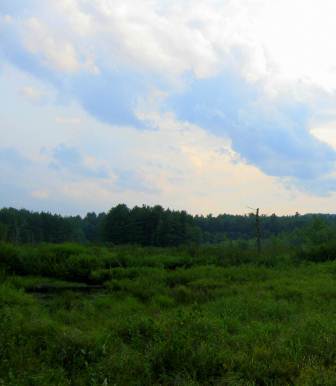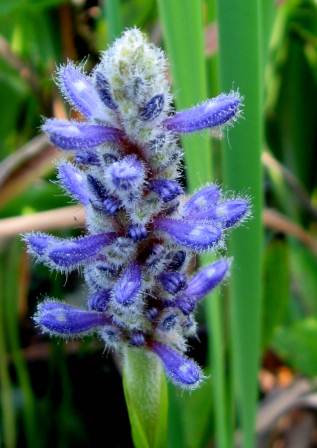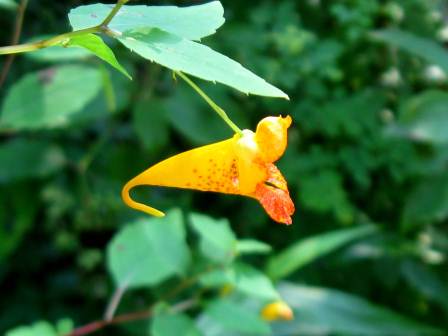This beautiful hedge bindweed (Calystegia sepium) blossom hints at the rain we finally got last weekend. It wasn’t enough but it helped. Though for many years all I ever saw were white flowered hedge bindweeds it has gotten to the point where all I see now are these bicolor ones. Bindweeds are perennial and morning glories are annuals and one good way to tell them apart is by their leaves; morning glory (Ipomoea) has heart shaped leaves and bindweed has narrower arrowhead shaped, triangular leaves.
Our native wintergreens are starting to blossom and chief among them is pipsissewa, in my opinion. Pipsissewa (Chimaphila umbellata) flowers often show a blush of pink. Five petals and ten chubby anthers surrounding a plump center pistil make it prettier than most of our other native wintergreens. Pipsissewa flowers are from 4-6 inches tall and nod toward the ground, which can make getting a good photo a challenge.
Pipsissewa grows in large colonies and is easy to find because of its shiny green leaves that shine winter and summer for up to 4 years before new leaves grow to replace them. Like other wintergreens it likes dry, sandy, undisturbed soil in pine forests. Pipsissewa was once used as a flavoring in candy and soft drinks, including root beer. It was also used medicinally by Native Americans. The word Pipsissewa is from the Native American Cree tribe and means “It-breaks-into-small-pieces,” referring to the belief that tea made from the dried leaves can break up kidney stones. It is still used by herbalists to treat urinary tract problems.
American basswood trees (Tilia americana) are members of the linden family. Though they are native trees I rarely see them. They belong to the same genus as the lime trees commonly seen in Europe and England. Its flowers are very fragrant and it’s a nice looking shade tree but unfortunately it is also an insect magnet and among the insects it attracts are Japanese Beetles in the many thousands. Bees are also attracted in great numbers and the honey produced from basswood foraging bees is said to be choice and highly sought after.
Each of the basswood’s flower clusters (cymes) clings to the middle of an elongated whitish green floral bract. Each small flower is about a half inch in diameter with 5 cream-colored petals, 5 cream-colored sepals, a pistil with a white style, and several stamens with yellow anthers. They were hard to get a good photo of for some reason, though I tried several times. The seeds are eaten by squirrels, chipmunks, and mice. Native Americans had many medicinal uses for the tree and made rope from its tough inner bark. Freshly cut bark was also used as bandages. Syrup was made from the sweet sap and young leaves were eaten in the spring. Not a single part of the tree was wasted.
Dwarf St. John’s wort (Hypericum mutilum) is a small, bushy plant that gets about ankle high and has flowers that resemble those found on its larger cousin, St. John’s wort. A noticeable difference, apart from their small size, is how the flowers lack the brown spots often found on the petals of the larger version. These flowers are about the same diameter as a pencil eraser and, since the plants often grow right at the water’s edge, you usually have to get wet knees to get a good photo of them.
There are a few lobelias that look similar but I think this one might be pale spike lobelia (Lobelia spicata,) which gets its common name from its small, pale blue to almost white flowers. Every now and then you can find a plant with deeper blue flowers, as I was lucky enough to do on this day. There is also a purple variant but I’ve never seen it. Native Americans had many medicinal uses for lobelia and one of them was as a treatment for asthma. The plant must have worked well because early explorers took it back across the Atlantic where it is still used medicinally today. It has to be used with great care by those who know how to use it though, because it can kill.
Canada lilies (Lilium canadense) are sometimes very tall and can tower over a person of average height. There must have been fifty plants in this location, some 8 feet tall and all in full bloom, and it looked like someone had hung yellow chandeliers from the trees. It’s a beautiful sight that I wish everyone could see but unfortunately mowing of the meadows that they like to grow in and digging up of the plants means scenes like that above are rarely seen. I’m very lucky to know of this place.
The flowers of Canada lilies are as big and as beautiful as the garden lilies I think we’re all familiar with and they come in red and orange as well as yellow. Their habit of nodding towards the ground can make getting a photo difficult, but I (very gently) tilt the stem back with one hand while I take the photos with the other. It’s not the ideal set up but it lets me show you the brownish purple spots on the inside throat of the trumpet and the huge red anthers. Speaking of anthers; many have found out the hard way that the pollen from those and other lily anthers will stain a white tablecloth permanently. The flower buds and roots were gathered and eaten by Native Americans. The scaly bulbs were cooked and eaten with other foods, such as venison and fish. They were also cooked and saved for winter use. They are said to have a very peppery flavor.
The common orange daylily (Hemerocallis fulva) doesn’t have Lilium in its scientific name because daylilies aren’t a true lily. It’s a plant you’ll find growing near old stone cellar holes out in the middle of nowhere and along old New England roads. It is also found in cemeteries, often planted beside the oldest graves. It is one of those plants that were passed from neighbor to neighbor and spread quickly because of it. These days it is one of those plants that new homeowners go out and dig up when they can’t afford to buy plants for their gardens. It is both loved for being so easy to grow and hated for being so common.
This plant was introduced into the United States from Asia in the late 1800s as an ornamental and plant breeders have now registered over 40,000 cultivars, all of which have “ditch lily” genes and all of which have the potential to spread just like the original has. If you find yourself doing battle with a particularly weedy daylily, no matter the color, there’s a very good chance that the common orange is one of its parents.
Meadowsweet (Spirea alba) grows in the form of a small shrub and is in the spirea family, which its flowers clearly show with their many fuzzy stamens. The flowers are fragrant and have a sort of almond-like scent. This plant was one of three considered most sacred by the Druids and has been used medicinally for many thousands of years. Here in America it is an introduced invasive, but little is heard about it and nobody seems to mind. I usually find it near water.
Purple loosestrife (Lythrum salicaria) is an invasive perennial that came over from Europe in the ballast of a cargo ship in the 1800s. The beach sand ballast, loaded with purple loosestrife seeds, was originally dumped on Long Island, New York. The seeds grew, the plant spread and now it covers most of Canada and all but 5 of the lower Untied States. It likes wet, sunny meadows but will grow just about anywhere.
It’s hard to deny the beauty of purple loosestrife, especially when you see a meadow full of it growing alongside yellow goldenrods. Such a sight can be breathtaking but the plant chokes out natives including goldenrod, and creates monocultures. I know of 2 places where you now see nothing but purple at this time of year.
The small, furry, white to light purple flowers of motherwort (Leonurus cardiaca) are easy to miss. At a glance this plant might resemble one of the nettle family but the square stems show it to be in the mint family. The tiny flowers grow in a whorl around the stem in the leaf axils. This plant, originally from Asia, is considered an invasive weed but I don’t see it that often and I don’t think I’ve ever seen more than 2 or 3 plants growing together. It was brought to this country because of its long history of medicinal use in Europe and Asia. It is found along roads and in fields.
The tiny flowers are very hairy and look like a microscopic orchid. They’re very hard to get a good shot of because of both their size and color. I had to go back to this plant 3 times and I’m still not really happy with the results. The ancient Greeks and Romans used motherwort medicinally and it is still used today to decrease nervous irritability and quiet the nervous system. There is supposed to be no better herb for strengthening and gladdening the heart, and it is sold in powdered and liquid form.
Spreading dogbane (Apocynum androsaemifolium) is toxic to both dogs and humans, but insects love it. It’s closely related to milkweeds and has milky sap like they do. Monarch butterflies drink its nectar and I saw one fly off a plant just a few days ago. Though it is an herbaceous perennial its growth habit makes it look like a 3 foot tall shrub. The Apocynum part of its scientific name means “away from dog.” Not only dogs but most other animals avoid it because of its toxic sap. Native Americans used the plant medicinally and used its strong fibers to make thread and cord. The plant’s milky white sap is very sticky and I wonder how they removed it from the thread they made.
Spreading dogbane’s bell shaped flowers are very fragrant and I love to smell then when I can find one without an insect in it. They’re also very pretty, with faint pink stripes on the inside. They remind me of lily of the valley flowers but are quite a lot larger, as the ant in the blossom pictured shows. I don’t know if the ants were looking for nectar or the honeydew left by aphids, because aphids also love the plant.
I know I showed blue vervain recently but it’s a beautiful thing and I can’t resist taking a photo or two when I see it. I found this example on a sandy part of the Ashuelot River Bank.
Flowers carry not only beauty but also the silent song of love. You just have to feel it. ~Debasish Mridha
Thanks for stopping in.























































 I’ve had a hard time getting close to this floating bladderwort (Utricularia radiate) but finally, after 2 months, I got close enough to get a decent photo and its flower was closed! Oh well-you’ll have to trust me when I say that the small yellow, snapdragon-like flower is unusual and beautiful. What I really wanted to point out about the plant are the unusual leaf stalks (petioles) that have evolved into floats. In the fall the plant forms what are called winter buds on its underwater stems. These buds and bits of stem are all that survive the winter on the pond bottom. In spring when the water warms they inflate and float to the surface where they start to grow into new plants. These plants float in ponds and slow moving streams and trap insects in underwater bladders.
I’ve had a hard time getting close to this floating bladderwort (Utricularia radiate) but finally, after 2 months, I got close enough to get a decent photo and its flower was closed! Oh well-you’ll have to trust me when I say that the small yellow, snapdragon-like flower is unusual and beautiful. What I really wanted to point out about the plant are the unusual leaf stalks (petioles) that have evolved into floats. In the fall the plant forms what are called winter buds on its underwater stems. These buds and bits of stem are all that survive the winter on the pond bottom. In spring when the water warms they inflate and float to the surface where they start to grow into new plants. These plants float in ponds and slow moving streams and trap insects in underwater bladders. I found this forget-me-not (Myosotis scorpioides) growing on a river bank. Books tell me that the plant grows naturally on the banks of streams and rivers, but this is the only time I’ve ever seen one there in spite of spending over 50 years exploring such places. There are over 50 species of forget-me-nots; some are native to North America and some are European natives.
I found this forget-me-not (Myosotis scorpioides) growing on a river bank. Books tell me that the plant grows naturally on the banks of streams and rivers, but this is the only time I’ve ever seen one there in spite of spending over 50 years exploring such places. There are over 50 species of forget-me-nots; some are native to North America and some are European natives.


 At first I thought this plant was northern bugleweed (Lycopus uniflorus) but I can’t find any reference to reddish leaves and dark purple stems for that plant. Instead, it must be the very similar looking taper leaf water horehound (Lycopus rubellus.) Its description includes both reddish leaves and stems which can be more purple than green, especially when it grows in bright light. Both plants love wet soil and are good wetland indicators. I found this one growing in full sun on a riverbank in a place that is often covered by water. I’ve seen it countless times but have really never paid it any attention.
At first I thought this plant was northern bugleweed (Lycopus uniflorus) but I can’t find any reference to reddish leaves and dark purple stems for that plant. Instead, it must be the very similar looking taper leaf water horehound (Lycopus rubellus.) Its description includes both reddish leaves and stems which can be more purple than green, especially when it grows in bright light. Both plants love wet soil and are good wetland indicators. I found this one growing in full sun on a riverbank in a place that is often covered by water. I’ve seen it countless times but have really never paid it any attention.
